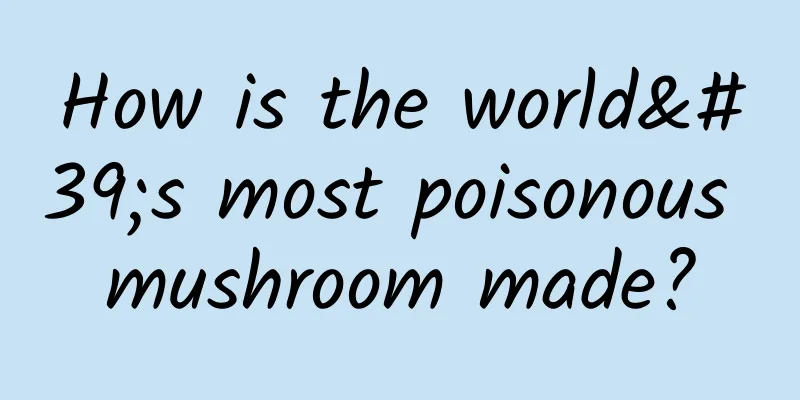How is the world's most poisonous mushroom made?

|
“Red umbrellas, white poles, after eating we lie down on the board together…”, this is a phrase with some black humor, which talks about the risks of picking and eating mushrooms in the wild. This is mainly because the various types of mushrooms are dazzling and it is difficult to tell whether they are poisonous or not. Do you know how many kinds of mushrooms there are in the world? This is a huge number. According to statistics, there are about 14,000 species of mushrooms known in the world. In my country, there are more than 4,000 known species, about 1,000 edible mushrooms with edible value, and about 500 poisonous mushrooms. Many poisonous mushrooms and edible mushrooms are similar in shape, and it is difficult for ordinary people to distinguish them in the wild, resulting in many poisoning incidents caused by eating poisonous mushrooms by mistake. According to the National Foodborne Disease Outbreak Reporting System, tens of thousands of people have been poisoned by poisonous mushrooms in the past 10 years, and nearly 1,000 people have died as a result. Mushroom poisoning has become one of the major issues endangering public health and safety. Today, we will explain to you why mushrooms are cute and beautiful on the outside, but so poisonous "inside"? How do professionals identify these mushrooms? 01 Amanita cyclotides: the culprit of mushroom toxicity Poisonous mushrooms have different toxin types and poisoning mechanisms, and mushrooms containing amatoxin are the undisputed king of poisons. More than 90% of deaths from mushroom poisoning in the world are caused by mushrooms containing amatoxin, and the type of poisoning caused is acute liver damage. Amanita cyclotoxin is very stable in chemical properties and is resistant to high temperatures, acids, alkalis and salts. General cooking methods will not destroy its toxicity. The most deadly of the amanita cyclotoxin toxins is α-amanitin (Figure 1). After accidentally eating mushrooms containing this type of toxin, the toxin enters the liver through the gastrointestinal tract and is quickly absorbed by liver cells, gradually depleting important proteins and enzymes in liver cells, and eventually leading to liver organ failure. Figure 1 α-amanitin (Photo source: Kunming Institute of Botany, Chinese Academy of Sciences) Mushrooms containing amanita cyclotides are distributed in the genera Amanita, Helmeted Agaricus and Cyclosporus in the order Agaricales (Figure 2). These mushrooms are distant relatives and grow in different environments. Amanita coexists with trees and is closely related to the healthy growth of trees, Helmeted Agaricus grows on rotten wood, and Cyclosporus grows in the soil. Figure 2 Mushrooms containing amatoxin (Photo source: Kunming Institute of Botany, Chinese Academy of Sciences) 02 Where does the deadly toxin come from? We see that these mushrooms grow in different environments and look different, but they all contain amatoxin. So why can these completely different mushrooms produce the most deadly toxins? Scientists in our country have found the answer. Recently, the Kunming Institute of Botany of the Chinese Academy of Sciences has made important progress in the study of the synthesis mechanism and evolution of amanita cyclotides. The researchers collected the above three types of mushrooms and completed the sequencing, building a complete platform for studying amanita cyclotides for the first time. The results of the study showed that although these mushrooms are quite different, they all produce amatoxins through the same similar production line (metabolic pathway), including the genes involved in the synthesis of amatoxins, which are highly similar. Currently, only four genes are known - MSDIN, POPB, P450-29 and FMO1. MSDIN is the precursor gene in the toxin production process, and POPB, P450-29 and FMO1 process and improve the precursor gene to form the final toxin. All three mushrooms have the ability to synthesize the most deadly alpha-amanitin toxins. However, the number and type of precursor genes (MSDIN) vary greatly. In Amanita, the precursor genes are abundant and can synthesize thousands of different amatoxins. In the Amanita cerana, there is only one precursor gene, which can only produce one toxin (α-amanitin). The number and types of precursor genes of the Agaricus cyclosporus are between Amanita phalloides and Amanita phalloides, with about 10 precursor genes. From this, it can be seen that Amanita phalloides is the strongest king in synthesizing toxins. The study reported for the first time two new genes (P450-29 and FMO1), which play a key role in the synthesis of toxins. Without these genes, the activity of the toxin will drop by more than 1,000 times, and it will lose its toxicity. Interestingly, this ability to produce toxins is not innate to them, but rather “borrowed.” Through “borrowing arrows from a straw boat” (horizontal gene transfer), another more ancient mushroom ancestor passed this ability to produce toxins to Amanita phalloides, Amanita aviculare, and Agaricus cyclosporus (Figure 3). Figure 3 Schematic diagram of the distribution of cyclopeptide toxin synthesis genes and metabolic pathway evolution in Amanita phalloides, Amanita argyi, and Agaricus cyclosporus (Photo source: Kunming Institute of Botany, Chinese Academy of Sciences) 03 How to identify poisonous mushrooms? Only professionals can be trusted Poisonous mushrooms are very "cunning" and may be life-threatening if eaten accidentally, so is there a simple way to identify mushrooms containing such toxins? The most common method is to judge whether a mushroom is poisonous by its appearance. This method is simple but has high risks because there are many similar edible mushrooms. However, it is difficult to operate with the help of advanced laboratory equipment, such as biochemical method, physical detection method, chromatography detection method and other complex methods. It is not impossible to quickly identify poisonous mushrooms. There is a quick and convenient testing method called the colorimetric method. The colorimetric method mainly involves grinding the mushrooms and dropping the ground liquid on newspapers. It then reacts with concentrated hydrochloric acid to produce a blue-green reactant. This method has a more professional name, called the Meixner test method. A research team has improved this method and developed an amatoxin detection kit (Figure 4), which shortens the detection time to 3 minutes, controls the hydrochloric acid concentration within a safe range, and can be operated in various conditions such as in the field. Figure 4 Rapid Detection Kit for Amanita Cyclopeptide Poisonous Mushrooms (Photo source: Kunming Institute of Botany, Chinese Academy of Sciences) After the test kit came out, it has been used in various hospitals and scientific research institutions and received unanimous praise, providing convenience for the prevention and treatment of poisonous mushroom poisoning. However, although this method is convenient, it is not recommended for foodies to use it on their own. For safety reasons, we still urge everyone to buy wild mushrooms in regular markets and not to eat mushrooms at will. After all, life safety is a matter of life and death, so don't take chances. Produced by: Science Popularization China Author: Lv Li Yunjiao (Kunming Institute of Botany, Chinese Academy of Sciences) Producer: China Science Expo The pictures in this article are from the copyright gallery and are not authorized for reproduction. |
>>: Iris recognition - the ID card hidden in the eyes
Recommend
RoboVM brings Java 8 programmers to iOS
[51CTO translation] RoboVM allows developers to u...
Don’t cram for the Gaofen satellite any more! Click here to learn what the Gaofen satellite’s high-resolution “eyes” can “see”.
As the understanding and research of the Earth de...
When is the cheapest time to buy a mobile phone? Insiders say
Changing your phone during Double 11 is undoubted...
The blue sky and white clouds were all gone. It’s not our fault. It’s because the camera is not powerful enough.丨World Photography Day
Produced by: Science Popularization China Author:...
Domestic Tesla was exposed to have secretly reduced its configuration. The official response said that it would upgrade related accessories for consumers free of charge
As Tesla's Shanghai Super Factory gradually r...
It is not difficult to observe with the naked eye, and the photos taken with mobile phones are very good. The big comet discovered by my country is back!
Produced by: Science Popularization China Author:...
Not just lung cancer! Why is it so hard to quit smoking?
Have you ever had such an experience? I finally w...
The chat tool is here! Baidu Input Method 10.0 version is released
In order to improve everyone's input efficien...
Android creator Andy Rubin: a genius envied by Steve Jobs
This year, China has been swept by an "Apple...
A brief discussion on Li Jiaqi’s private domain traffic strategy!
Li Jiaqi may be one of the hottest names in 2019....
iPhone 6 locked remotely: Don't use it if you don't pay
I just bought an iPhone 6, but it was suddenly lo...
Mimi Meng, Youshu, Tongdao Dashu, Xin Shixiang... How do they attract fans?
We often say that the biggest difference between ...
Take this little blue pill and the whole world turns blue...
Drugs can help relieve illness, but sometimes the...
The Ministry of Industry and Information Technology's "hope" cannot save the domestic operating system
Since Microsoft stopped supporting the Windows XP ...
What does SEO strategy mainly include?
What does SEO strategy mainly include? A few year...









